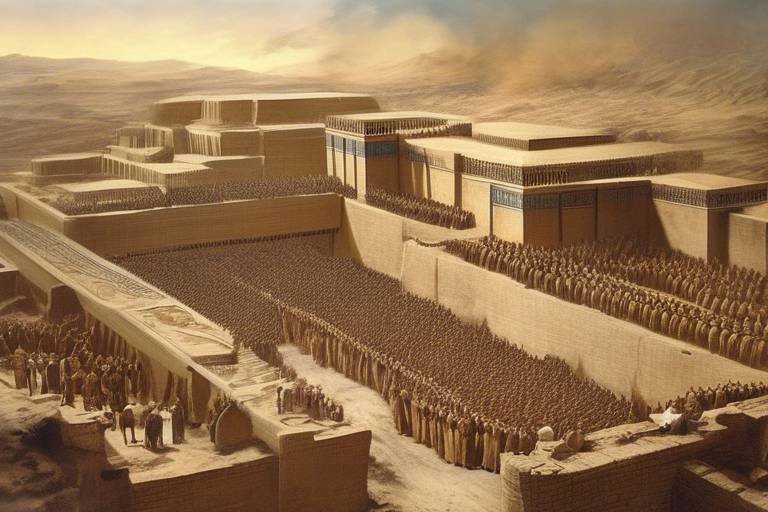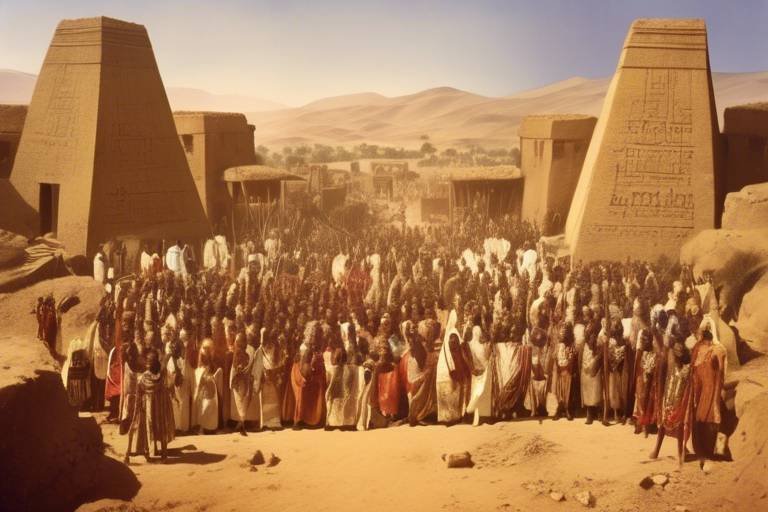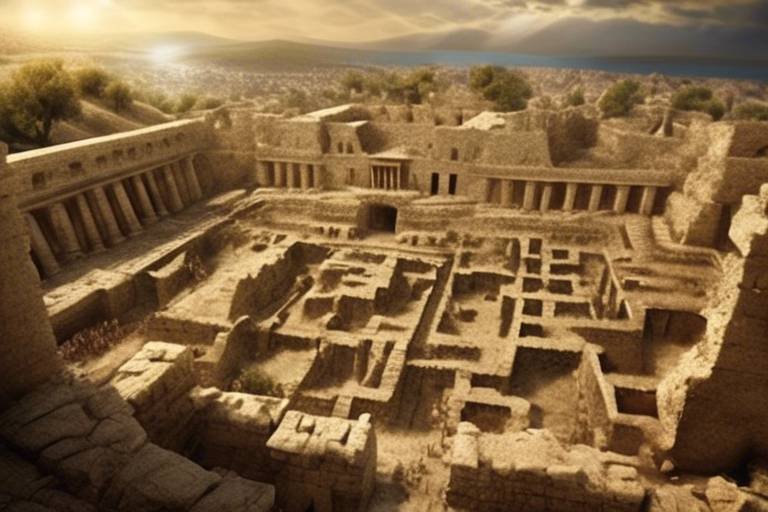The Rise and Fall of the Babylonian Empire - A Study
When delving into the annals of history, one cannot overlook the remarkable tale of the Babylonian Empire. This ancient civilization, situated in the heart of Mesopotamia, rose to prominence with a blend of military prowess, cultural achievements, and architectural marvels. However, like all great empires, the Babylonian Empire too faced the inevitable - a gradual decline that marked the end of its reign as a dominant force in the ancient world.
The story of the Babylonian Empire begins with its humble origins, where a series of city-states in the region eventually coalesced into a unified kingdom under the rule of Hammurabi. This consolidation laid the groundwork for Babylon to emerge as a major power, setting the stage for its future conquests and cultural achievements.
During the Golden Age of Babylon, under the reign of Nebuchadnezzar II, the empire reached its zenith. The city of Babylon flourished with architectural wonders like the Hanging Gardens, advancements in astronomy and mathematics, and a flourishing of arts and literature that left a lasting impact on the ancient world.
As Babylon expanded its territories through conquests and strategic alliances, its influence spread far and wide. Military campaigns led by ambitious kings added new lands to the empire, while administrative innovations helped in governing diverse regions with varying cultures and languages.
However, the seeds of Babylon's downfall were sown within its own borders. Internal strife, economic challenges, and administrative issues weakened the empire from within, making it vulnerable to external invasions by rising powers in the region.
Despite its eventual decline, the legacy of the Babylonian Empire endures through its contributions to art, architecture, language, and legal systems. The Ishtar Gate, ziggurats, and cuneiform inscriptions serve as testaments to the creativity and ingenuity of the Babylonians, influencing subsequent civilizations for centuries to come.
Religion played a central role in Babylonian society, with deities like Marduk and Ishtar worshipped through elaborate rituals and ceremonies. The practice of divination and the construction of grand temples underscored the spiritual beliefs that permeated every aspect of daily life in ancient Babylon.
Even in modern times, the influence of the Babylonian Empire can be felt in the fields of archaeology, history, and cultural heritage preservation. Scholars continue to study and unravel the mysteries of this ancient civilization, shedding light on its complexities and significance in shaping the course of human history.

Origins of the Babylonian Empire
The Babylonian Empire had its origins in the ancient city of Babylon, located in the region of Mesopotamia. The early foundations of Babylon date back to the third millennium BCE when it was a small town on the Euphrates River. However, it was under the rule of Hammurabi in the 18th century BCE that Babylon began to emerge as a significant power in the region. Hammurabi's Code, a set of laws inscribed on a stele, is a testament to the city's early legal system and administrative structure.
With the unification of the region under Hammurabi's reign, Babylon became the capital of a growing empire that extended its influence over neighboring city-states. The strategic location of Babylon along major trade routes contributed to its economic prosperity and political significance. The city's rise to power marked the beginning of the Babylonian Empire as a dominant force in ancient Mesopotamia.
As Babylon continued to expand its territories, subsequent rulers built upon the foundations laid by Hammurabi, further solidifying the empire's control over the region. The city's growth and development attracted skilled craftsmen, traders, and scholars, leading to advancements in various fields such as astronomy, mathematics, and literature. The cultural achievements of Babylon during this period laid the groundwork for its golden age under Nebuchadnezzar II.

Golden Age of Babylon
The represents a remarkable period in the history of the Babylonian Empire, characterized by unprecedented cultural, scientific, and architectural achievements. Under the reign of King Nebuchadnezzar II, Babylon flourished as a center of innovation and grandeur, solidifying its status as a dominant power in the ancient world.
During this era, Babylon experienced a renaissance in various fields, with significant advancements in science, literature, and arts. The city's skyline was adorned with architectural marvels, such as the famous Ishtar Gate, a symbol of Babylon's opulence and sophistication. The construction of massive ziggurats showcased the Babylonians' engineering prowess and devotion to their religious beliefs.
Nebuchadnezzar II's patronage of the arts and sciences fostered a vibrant cultural scene in Babylon. The city became a hub of intellectual exchange, attracting scholars, poets, and artisans from far and wide. The flourishing of cuneiform writing allowed for the preservation of knowledge and literature, providing insights into Babylonian society and customs.
Moreover, the Golden Age witnessed significant astronomical and mathematical achievements, with Babylonian astronomers making groundbreaking observations of celestial bodies and developing sophisticated mathematical systems. Their contributions laid the foundation for future scientific endeavors and influenced later civilizations.
Artistic expression thrived during this period, with intricately crafted statues and clay tablets showcasing the Babylonians' mastery of craftsmanship and storytelling. The rich symbolism and intricate details of Babylonian art reflect the society's reverence for beauty, spirituality, and cultural heritage.
The Golden Age of Babylon stands as a testament to the ingenuity and creativity of the Babylonian people, leaving a lasting legacy of artistic excellence, scientific innovation, and cultural sophistication that continues to inspire and captivate modern audiences.

Conquests and Expansion
Exploring the historical timeline, key events, rulers, cultural achievements, and factors contributing to the ascent and decline of the influential Babylonian Empire in ancient Mesopotamia.
During its peak, the Babylonian Empire embarked on ambitious military campaigns that significantly expanded its territories and influence across ancient Mesopotamia. Led by formidable rulers such as Hammurabi and Nebuchadnezzar II, Babylon's conquests were marked by strategic brilliance and military prowess.
One of the most notable conquests was the capture of the city of Mari, a key trading hub along the Euphrates River. This victory not only secured valuable resources for Babylon but also established its dominance in the region, paving the way for further expansion.
Utilizing a combination of diplomacy, military might, and administrative acumen, Babylonian kings extended their rule over diverse populations, including the Sumerians, Akkadians, and Assyrians. Through alliances and strategic alliances, the empire solidified its control over a vast expanse of land, from the Persian Gulf to the Mediterranean Sea.
The Babylonians employed innovative tactics in their conquests, such as siege warfare and the use of chariots in battle. These military advancements enabled them to overcome formidable opponents and assert their dominance over rival city-states and kingdoms.
Moreover, Babylon's expansionist policies were not solely driven by territorial ambitions but also aimed at fostering cultural exchange and economic prosperity. The empire's conquests facilitated the spread of Babylonian culture, language, and legal systems, influencing the development of neighboring societies.
Despite facing occasional setbacks and rebellions from conquered territories, the Babylonian Empire's conquests and expansion efforts were instrumental in shaping the geopolitical landscape of ancient Mesopotamia and establishing Babylon as a formidable power in the ancient world.

Decline of the Babylonian Empire
As the Babylonian Empire reached its zenith, it also sowed the seeds of its own downfall. The decline of this once-mighty empire was a complex interplay of various factors that gradually eroded its power and influence over time.
Internal strife plagued Babylon, with power struggles among the ruling elite leading to political instability and weakening central authority. This infighting weakened the empire's ability to govern effectively and respond to external threats, creating vulnerabilities that were exploited by rival states.
External invasions further exacerbated the Babylonian Empire's decline. Invasions by neighboring powers, such as the Assyrians and Persians, put immense pressure on Babylon's borders and resources, gradually chipping away at its territorial integrity and diminishing its military strength.
Economic challenges also played a significant role in the empire's decline. The cost of maintaining a vast empire, coupled with declining revenues from trade and agriculture, strained Babylon's economy and led to financial difficulties. This economic strain weakened the state's ability to support its infrastructure and military, further hastening its decline.
Administrative issues further contributed to the Babylonian Empire's downfall. Inefficient governance, corruption, and bureaucratic inefficiencies hampered the empire's ability to effectively manage its vast territories and diverse populations. This lack of effective administration made it difficult for Babylon to address the challenges it faced, ultimately contributing to its decline.
As these various factors converged, the Babylonian Empire gradually lost its grip on power and influence, paving the way for its eventual collapse and the rise of new powers in the ancient Near East.

Legacy of the Babylonian Empire
The legacy of the Babylonian Empire is a profound and enduring one, leaving an indelible mark on the civilizations that followed in the Near East and beyond. One of the most significant contributions of the Babylonians was their legal system, famously codified in the Code of Hammurabi. This code, one of the earliest known sets of laws, influenced legal practices in ancient and modern societies alike, emphasizing principles of justice, fairness, and accountability.
Babylonian culture also made lasting impacts in the field of astronomy and mathematics. The Babylonians were skilled astronomers, developing a sophisticated system of tracking celestial movements and creating one of the earliest known astronomical calendars. Their mathematical achievements, particularly in the development of the base-60 numeral system, laid the foundation for future mathematical advancements.
Furthermore, the Babylonians were renowned for their architectural prowess, constructing monumental structures such as the Ishtar Gate and the hanging gardens of Babylon. These architectural marvels not only showcased the engineering skills of the Babylonians but also served as symbols of their wealth, power, and cultural sophistication.
In the realm of literature, the Babylonians made significant contributions through their rich tradition of cuneiform writing. This script, etched into clay tablets, preserved a wealth of literary works, myths, and historical records, providing valuable insights into Babylonian society, beliefs, and daily life.
Moreover, the Babylonian Empire's influence extended to religious practices, with the worship of deities such as Marduk and Ishtar shaping religious beliefs in the region for centuries to come. Their elaborate temple rituals, divination practices, and religious ceremonies laid the groundwork for the development of subsequent religious traditions in the ancient Near East.
Overall, the legacy of the Babylonian Empire is a multifaceted tapestry of cultural, legal, scientific, and artistic achievements that continue to resonate in modern society. By studying and appreciating the contributions of the Babylonians, we gain a deeper understanding of the foundations of human civilization and the enduring impact of ancient cultures on our contemporary world.

Religious Beliefs and Practices
Exploring the historical timeline, key events, rulers, cultural achievements, and factors contributing to the ascent and decline of the influential Babylonian Empire in ancient Mesopotamia.
Religion played a pivotal role in Babylonian society, shaping every aspect of life from governance to daily rituals. The Babylonians worshipped a pantheon of deities, with Marduk, the chief god, holding a central position in their belief system. Ishtar, the goddess of love and war, was also widely venerated, reflecting the Babylonians' complex understanding of divinity.
The practice of divination, the interpretation of signs and omens to predict the future, was a common religious practice in Babylon. Priests and priestesses served as intermediaries between the people and the gods, conducting elaborate rituals and ceremonies to ensure divine favor and protection.
The Babylonians constructed grand temples dedicated to their gods, such as the famous Esagila temple in Babylon. These sacred spaces were adorned with intricate carvings, statues, and offerings, serving as centers of spiritual and communal life.
Ceremonies and festivals were integral to Babylonian religious life, marking important occasions and honoring the gods. The Akitu festival, held annually to celebrate the Babylonian New Year, involved processions, feasting, and prayers for prosperity and renewal.
Through their religious beliefs and practices, the Babylonians sought to maintain harmony with the divine realm, seeking protection, guidance, and blessings for their community and empire.
Q: What was the significance of Marduk in Babylonian religion?
A: Marduk was regarded as the supreme deity in the Babylonian pantheon, representing power, wisdom, and divine authority. His victory over the chaos dragon Tiamat was central to Babylonian cosmology.
Q: How did Babylonian priests communicate with the gods?
A: Babylonian priests used various methods of divination, including observing the flight of birds, interpreting celestial phenomena, and examining the livers of sacrificial animals to receive messages from the gods.
Q: What role did temples play in Babylonian society?
A: Temples served as religious, social, and economic centers in Babylonian cities, hosting ceremonies, offering services to the community, and managing vast estates and resources.
Q: Were women involved in Babylonian religious practices?
A: Yes, women held important roles as priestesses, singers, and ritual participants in Babylonian religious ceremonies, contributing to the spiritual life of the community.

Art and Architecture of Babylon
The art and architecture of Babylon stand as a testament to the creativity and ingenuity of the ancient Babylonians. One of the most iconic architectural achievements of Babylon is the Ishtar Gate, a magnificent entryway adorned with vibrant glazed bricks depicting dragons and bulls. This gate served as a grand entrance to the city and showcased the wealth and power of Babylon.
Additionally, the Babylonians were known for their impressive ziggurats, towering structures with multiple levels that served as temples to the gods. The most famous ziggurat in Babylon was the Etemenanki, also known as the Tower of Babel, which was believed to be a link between heaven and earth. These architectural wonders not only served religious purposes but also demonstrated the Babylonians' advanced engineering skills.
Furthermore, Babylonian art encompassed a wide range of mediums, including statues, relief carvings, and clay tablets inscribed with cuneiform script. The statues of Babylonian deities and rulers were intricately crafted, capturing the essence of the individuals they represented. These sculptures were not only artistic expressions but also served religious and political purposes, symbolizing power and divine connections.
The use of cuneiform script on clay tablets was another significant artistic achievement of the Babylonians. These tablets contained a wealth of information, including literature, legal documents, and historical records. The intricate writing system of cuneiform was a hallmark of Babylonian culture and played a crucial role in preserving their history and knowledge for future generations.
In conclusion, the art and architecture of Babylon reflect the rich cultural heritage and artistic prowess of this ancient civilization. From the grandeur of the Ishtar Gate to the intricacy of cuneiform script, Babylonian art and architecture continue to captivate and inspire modern audiences, providing a glimpse into the vibrant world of ancient Mesopotamia.

Enduring Influence on Modern Society
The enduring influence of the Babylonian Empire on modern society is profound and far-reaching. Despite the passage of millennia, the legacy of Babylon continues to shape our understanding of ancient history and influence various aspects of contemporary life. One of the most significant contributions of the Babylonians is their legal system, particularly the Code of Hammurabi. This early legal code, with its principles of justice and punishment, has had a lasting impact on legal systems around the world.
Furthermore, Babylonian advancements in mathematics and astronomy have laid the foundation for modern scientific knowledge. The Babylonians were skilled astronomers, developing sophisticated techniques for observing celestial bodies and creating complex mathematical systems. Their contributions to these fields have influenced scientific thought and exploration to this day.
Moreover, the architectural achievements of the Babylonians, such as the construction of ziggurats and the iconic Ishtar Gate, have inspired architects and designers throughout history. The grandeur and innovation of Babylonian architecture continue to be admired and replicated in modern structures around the world.
Additionally, the Babylonian influence on language and writing systems is evident in the continued study and preservation of cuneiform script. Scholars and linguists continue to decipher and analyze Babylonian texts, shedding light on ancient cultures and civilizations. The preservation of this ancient writing system underscores the enduring legacy of Babylonian culture.
Overall, the Babylonian Empire's enduring influence on modern society serves as a testament to the lasting impact of ancient civilizations on our contemporary world. From law and science to architecture and language, the contributions of the Babylonians continue to resonate and inspire further exploration and discovery in diverse fields.
Frequently Asked Questions
- What were the major achievements of the Babylonian Empire?
The Babylonian Empire made significant contributions to the fields of mathematics, astronomy, and law. They are known for creating the Code of Hammurabi, one of the earliest known legal codes. Additionally, Babylonian astronomers made important advancements in tracking celestial movements and developing the concept of the zodiac.
- How did religion influence Babylonian society?
Religion played a central role in Babylonian society, with various deities worshipped and rituals performed to seek their favor. The Babylonians believed in a pantheon of gods and goddesses, with Marduk being the chief deity. Rituals, sacrifices, and temple ceremonies were common practices to appease the gods and ensure prosperity.
- What was the significance of Babylonian art and architecture?
Babylonian art and architecture were highly advanced for their time, with the construction of grand structures like the Ishtar Gate and ziggurats. The Babylonians excelled in sculpting, pottery, and the use of cuneiform script on clay tablets. These artistic achievements not only served practical purposes but also reflected the cultural and religious beliefs of the empire.
- How did the decline of the Babylonian Empire impact future civilizations?
The decline of the Babylonian Empire paved the way for the rise of other powers in the region, such as the Assyrians and Persians. Despite its fall, Babylonian culture, language, and legal systems continued to influence subsequent civilizations in the Near East and beyond. The legacy of the Babylonian Empire can be seen in the development of written laws, religious practices, and architectural styles in later societies.



















